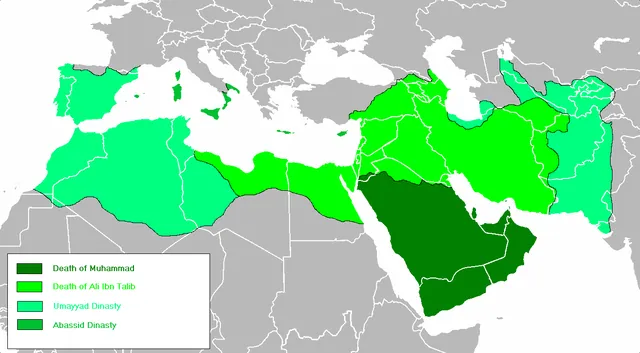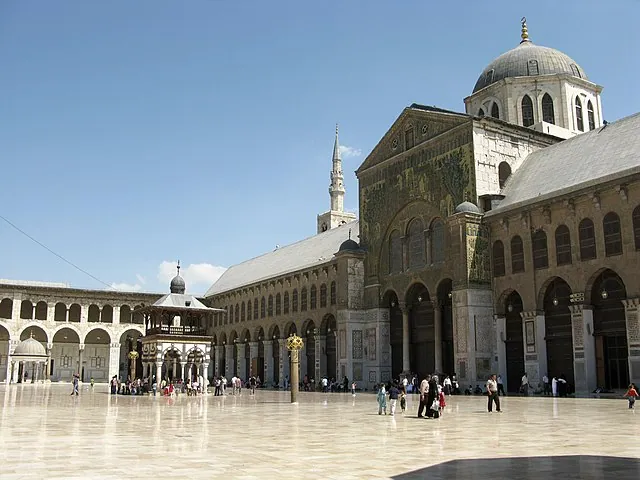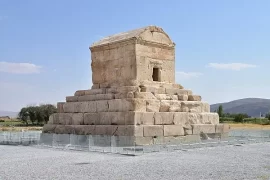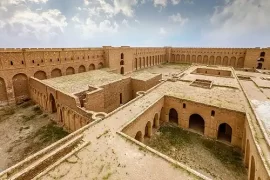The Umayyad Caliphate was the second Islamic caliphate after the death of Prophet Muhammad in 632 CE. It is named after Muawiyah ibn Abi Sufyan, who established the dynasty in 661 CE. The Umayyad Caliphate lasted for nearly a century, from 661 CE to 750 CE, and was known for its military conquests, cultural achievements, and administrative reforms.
History of Umayyad Caliphate
Foundation of Umayyad dynasty
The Umayyad Caliphate emerged in the aftermath of the First Muslim Civil War (656-661 CE), which broke out after the assassination of the third Caliph, Uthman ibn Affan. The conflict was between the supporters of Ali ibn Abi Talib, the Prophet’s cousin and son-in-law, and the supporters of Muawiyah ibn Abi Sufyan, the governor of Syria and a member of the Umayyad clan. Muawiyah ibn Abi Sufyan, the first Umayyad caliph, refused to support ʿAli ibn Abi Talib’s claim to power and demanded the punishment of those responsible for ʿUthman’s murder. The ensuing conflict between Muawiyah and Ali was characterized by sporadic fighting and prolonged negotiations. The major standoff at Siffin ended with both sides backing down and a complex arbitration process. Dissatisfied followers of Ali rebelled against him and a Kharijite assassin killed him, handing Muʿawiya victory. Ali’s generals and sons conceded the caliphate to Muawiyah. He became the Caliph, founding the Umayyad dynasty.

Succession conflict
After almost two decades in power, Mu’awiya set a precedent by arranging for his son, Yazid, to succeed him as caliph, creating the first dynastic succession in Islamic history.
Yazid’s actions caused opposition to rally around two leaders, al-Husayn ibn Ali and Abdallah ibn al-Zubayr. Although both opposition groups failed, al-Husayn’s attempt to restore his family to power was spectacular both for its utter failure and for its long-term impact. The memory of al-Husayn’s martyrdom became the seminal event in the eventual emergence of the Shiʿite sect, producing a permanent schism in the Muslim community.
Ibn al-Zubayr presented a more formidable challenge to the Umayyads. He commanded significant support in Medina and other Arabian cities. Umayyad efforts to repel his advances stumbled after Yazid died suddenly in 683. His son Mu’awiya II was not a strong leader and his death within weeks of his accession deepened the crisis for the Umayyads. Ultimately, Umayyad leaders chose Marwan ibn al-Hakam as their new standard bearer. Marwan was able to rally the Syrians to resist Ibn al-Zubayr and turned the tide of his advances in a major battle at Marj Rahit in 684. However, with the death of Marwan in 685, Ibn al-Zubayr outlasted yet another Umayyad foe.
Marwan’s son and successor, Abd al-Malik, spent the next seven years fighting Ibn al-Zubayr’s resilient forces, aided unintentionally by Shi’ite rebels in Kufa who rose up against Ibn al-Zubayr from 685 to 687. The rebellion was led by al-Mukhtar ibn Abi Ubayd who advanced Ali’s third son, Muhammad ibn al-Hanafiyya, as the rightful leader of the Muslim community.
However, Ibn al-Zubayr could not afford to lose control of Kufa and Basra, two important cities in Iraq, to a Shiʿite rebel. Therefore, he had to defeat al-Mukhtar and pacify Iraq to maintain his authority over the region. In addition, Ibn al-Zubayr faced rebellions from the Kharijites, a sect of Islam that rejected the authority of both the Umayyads and Ibn al-Zubayr. He managed to defeat the Arabian rebels in 691, but the Kharijites in Iran continued to resist his rule.
Abd al-Malik appointed his ruthless and efficient general, al-Hajjaj ibn Yusuf, to quell the rebellion in Mecca. In 692, after an intense battle that even damaged the holy site of the Kaʿba, Ibn al-Zubayr was killed, and the unity of the Muslim community was restored, with ʿAbd al-Malik as its caliph.
Expansion of Empire
The Umayyad Caliphate was based in Damascus, and it expanded rapidly during its early years. The Caliphs led several successful military campaigns against the Byzantine Empire in the east and the Sassanian Empire in the west, conquering vast territories in the process. The Umayyads also expanded into North Africa, Spain, and Central Asia, making it one of the largest empires in history.
List of Umayyad Caliphs
| SN | Caliph name | Reign |
| 1 | Muawiya I ibn Abu Sufyan | 28 July 661 – 27 April 680 |
| 2 | Yazid I ibn Muawiyah | 27 April 680 – 11 November 683 |
| 3 | Muawiya II ibn Yazid | 11 November 683 – June 684 |
| 4 | Marwan I ibn al-Hakam | June 684 – 12 April 685 |
| 5 | Abd al-Malik ibn Marwan | 12 April 685 – 8 October 705 |
| 6 | al-Walid I ibn Abd al-Malik | 8 October 705 – 23 February 715 |
| 7 | Sulayman ibn Abd al-Malik | 23 February 715 – 22 September 717 |
| 8 | Umar ibn Abd al-Aziz | 22 September 717 – 4 February 720 |
| 9 | Yazid II ibn Abd al-Malik | 4 February 720 – 26 January 724 |
| 10 | Hisham ibn Abd al-Malik | 26 January 724 – 6 February 743 |
| 11 | al-Walid II ibn Yazid | 6 February 743 – 17 April 744 |
| 12 | Yazid III ibn al-Walid | 17 April 744 – 4 October 744 |
| 13 | Ibrahim ibn al-Walid | 4 October 744 – 4 December 744 |
| 14 | Marwan II ibn Muhammad (ruled from Harran in the Jazira) | 4 December 744 – 25 January 750 |
Achievements of Umayyad Caliphate
The Umayyad Caliphate was known for its cultural and intellectual achievements, which were influenced by the Byzantine and Persian cultures. The Caliphs patronized scholars, poets, and artists, and created a rich intellectual and cultural environment that contributed to the development of Islamic civilization.
Umayyad Architecture

Umayyads oversaw the construction of some of the most impressive and innovative buildings of their time, including mosques, palaces, and other monumental structures.
One of the most notable achievements of Umayyad architecture was the development of the hypostyle mosque, which became the standard form for Islamic worship spaces. The Great Mosque of Damascus, built by the Umayyad caliph Al-Walid I in the early 8th century, is considered one of the finest examples of hypostyle mosque architecture. It features a large central courtyard surrounded by a series of columns and arches, with a dome and minaret added in later periods.
Another major innovation of Umayyad architecture was the use of muqarnas, a type of decorative vaulting that uses complex geometrical patterns to create a three-dimensional effect. Muqarnas were used extensively in Umayyad palaces, including the Alhambra in Granada, Spain, which was built by later Muslim rulers during the 14th century.
Umayyad architecture also saw the development of new forms of decorative art, such as the use of mosaics and ornate calligraphy. The Dome of the Rock is famous for its intricate tile work and inscriptions in both Arabic and ancient Hebrew.
Despite the fact that many Umayyad buildings have been destroyed or altered over the centuries, their legacy lives on in the form of later Islamic architecture. Many of the innovations developed during the Umayyad period were refined and expanded upon by subsequent dynasties, including the Abbasids, Fatimids, and Mughals. Today, the legacy of Umayyad architecture continues to inspire architects and designers around the world.
Major Umayyad Monuments
Dome of the Rock
One of the most significant achievements of the Umayyad Caliphate was the construction of the Dome of the Rock in Jerusalem, which is considered one of the most important architectural and religious landmarks in the world. The Dome of the Rock is a shrine that houses the rock on which Prophet Muhammad is believed to have ascended to heaven. The building is an architectural masterpiece that combines Byzantine, Persian, and Islamic styles, and it has inspired many other religious buildings around the world.

Education
The Umayyad Caliphate also made significant advances in science, medicine, and mathematics. Scholars such as Al-Khwarizmi and Al-Farabi made important contributions to algebra, trigonometry, and philosophy, while the physician Al-Razi made significant advances in medicine. The Umayyads also promoted the translation of Greek, Persian, and Indian texts into Arabic, which helped to preserve and spread ancient knowledge.
Administrative Innovations
The Umayyads were also known for their administrative reforms, which helped to establish a centralized and efficient government. The Caliphs established a system of taxation, which was based on landownership, and they created a professional bureaucracy to administer the empire. The Umayyads also standardized the Arabic language and currency, which facilitated trade and communication.
Legacy of Umayyad Caliphate
The Umayyad Caliphate had a significant impact on Islamic civilization and the wider world. The Umayyads were the founders of the first Islamic dynasty and established the precedent for dynastic rule in the Muslim world, which endured for centuries. Their imperial culture laid the foundation for subsequent Islamic empires.
They helped to spread Islam to new regions, and it established a powerful empire that influenced the politics, culture, and economics of the medieval world.
They also contributed to the development of Islamic art and architecture. They introduced new forms of decoration, such as calligraphy, and they created new architectural styles, such as the horseshoe arch and the muqarnas. These innovations influenced later Islamic art and architecture, as well as the art and architecture of other cultures.
The Umayyad dynasty also had a profound impact on the politics of the Islamic world. Their imperial culture laid the foundation for subsequent Islamic empires. The Caliphate had a profound impact on the politics of the Islamic world. It set the precedent for the Sunni-Shia divide, as the Umayyads were seen as usurpers by the followers of Ali and his descendants. This division has had lasting implications for the political and religious landscape of the Islamic world.
The Umayyads were also criticized for their policies towards non-Arab Muslims, who were often treated as second-class citizens. This policy led to resentment among non-Arab Muslims, and contributed to the downfall of the Umayyad dynasty.
The Umayyad Dynasty ultimately came to an end in 750 CE, when it was overthrown by the Abbasid revolution. The Abbasids, who were supported by the Shia and non-Arab Muslims, established a new dynasty and moved the capital of the Caliphate to Baghdad.
Summary of Umayyad Caliphate
The Umayyad Caliphate was a significant period in Islamic history, marked by military conquests, cultural achievements, and administrative reforms. The Caliphs of the Dynasty left a lasting legacy, influencing Islamic civilization and the wider world in numerous ways. While the Umayyads were not without their flaws and criticisms, their impact on Islamic history cannot be overstated.







